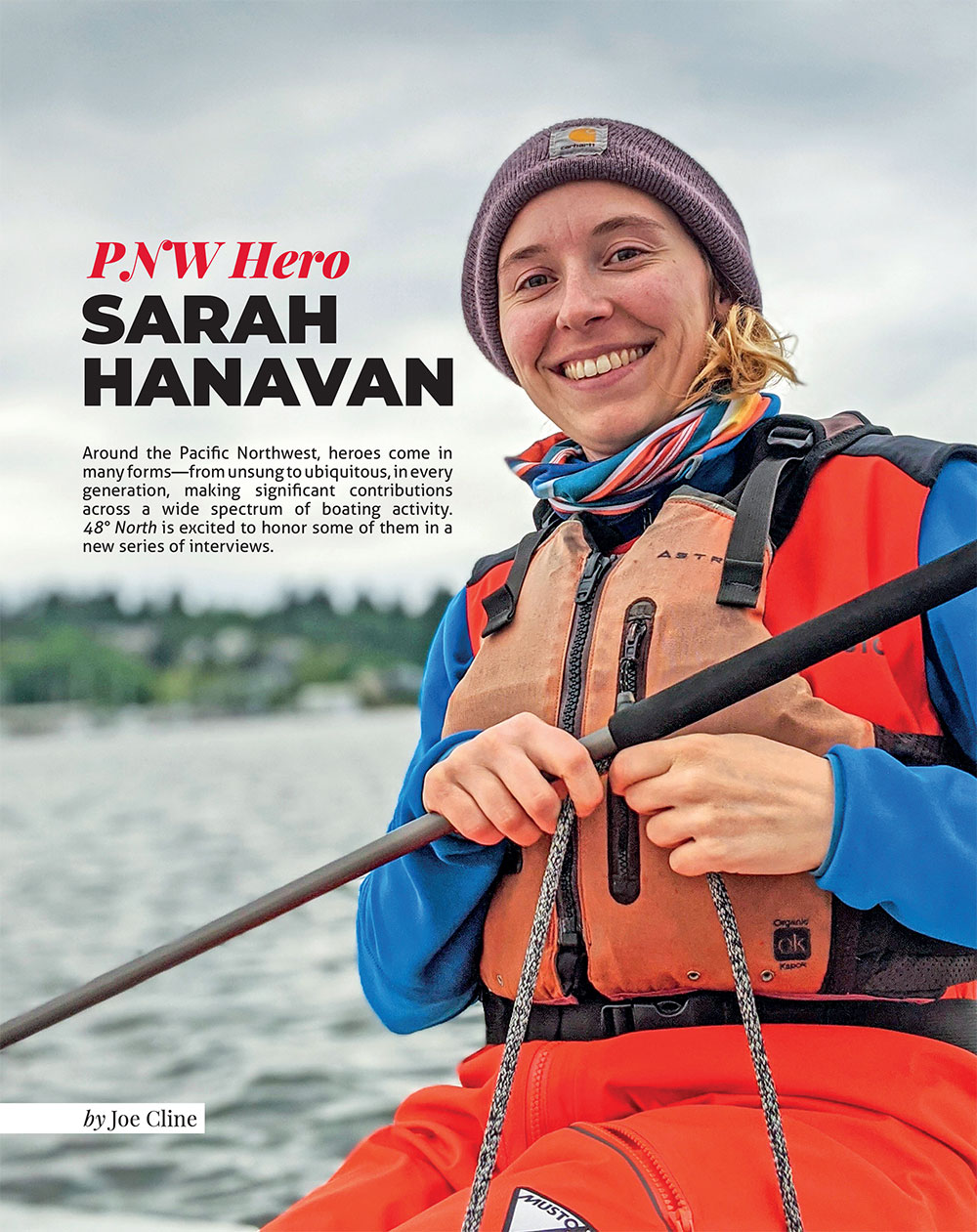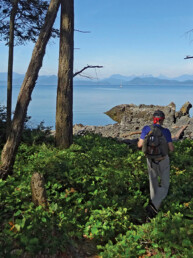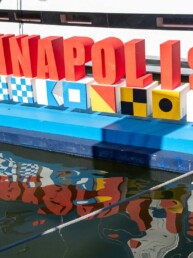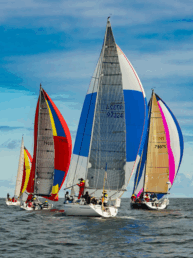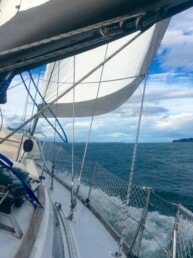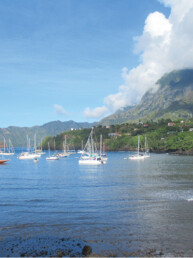Growing a yacht club youth program from 4 participants to more than 60 in four years; coaching her high school racers to achieve the highest-ever finish for a Northwest team at a Mallory Cup Fleet Racing National Championship; creating and leading the first ever US Sailing Women’s Coaching Clinic… Olympia’s Sarah Hanavan is definitely one of our heroes!
A condensed version of this interview was published in the July 2020 issue of 48° North.
48° North: Tell us about your entry into the world of sailing.
Sarah Hanavan: I grew up on Bainbridge Island. My mom signed my brother and me up for parks and rec classes—your generic summer sailing camps. We did that every summer up until high school, into freshman or sophomore year. The parks and rec camps on Bainbridge are wonderful, they’ve been going on at least two or three decades. There wasn’t really a racing component to them, just the exposure of getting to go sailing in Eagle Harbor every summer was really wonderful.
I was actually able to do that through a scholarship program. My mom is a single mom, so it wasn’t something she would have been able to afford if she hadn’t been able to use that program.
From there, I got interested in racing competitively. It didn’t work out very well with my schedule to do it full-time with the Bainbridge Island High School team, because I was doing Running Start. But I made a point of revisiting racing in college at Western Washington University, and I joined the Western Sailing Team. And from there, I just never looked back.
You are one of many influential sailors across the generational spectrum to have roots with the Western Sailing Team. Can you share more about that experience?
The Western Sailing Team is so special. There’s something about that team in particular that has a soul that is hard to describe—it’s a special feeling when you join the team, like anything is possible. I was really fortunate to be on the team during a time when there was an upwelling of really intense competitive interest. Over my four years of being on the team, we had a core group of 10-15 competitors who were pushing for things as lofty as doing well at Nationals and seeking careers in sailing. We viewed sailing as our full-time job in school, which was cool to experience because it was a club sport team; it wasn’t (and still isn’t) funded by the university.
Pretty much every weekend for four years, there were regattas. I was captain for two years— running the team, hosting regattas, and corresponding with other programs and their coaches. We would bring anywhere from 20 to 24 sailors down to an event in California, which is just insane. We would drive four or five cars with the boats on trailers; we would have to figure out charters and accommodations with the teams down there. We’d spend three days doing all of this and then get all 24 students back for class on Monday.
A lot of the experience that I had—both with my friends on the team and with team management—has helped me become a well-rounded adult, and to build a lot of skill sets for management and organizational work. When you’re in college, you don’t realize how valuable those things are and how applicable they are to so many careers or pursuits as a community member. I love the team for this.
We had a team member who took his own life when I was a Junior. That was very emotional and really changed the tone and focus of the team for the next year. That was a really pivotal moment for me as young sailor, because it could have either been a moment when I either walked away from the sport and had a bad association with it, or really buckled down because I had the sport and the team to get through experience. It made me fall in love with it on another level. So yes, the Western Sailing Team had a huge impact on my life.
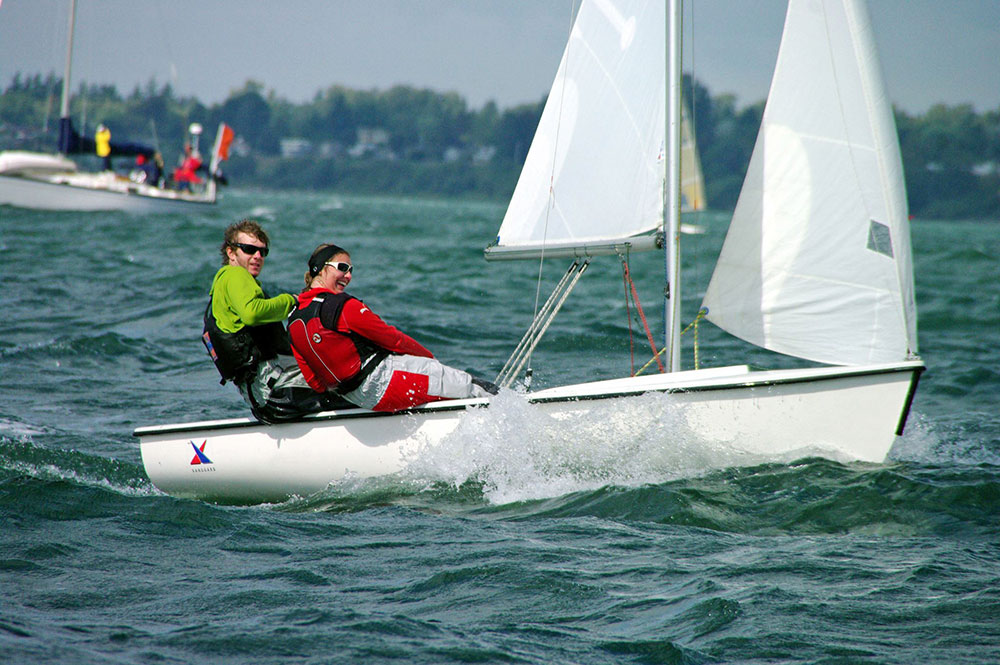
Would you share a bit about your transition from being a college sailor to working in sailing professionally?
When I was in college, I had worked summers as Head Coach at Treasure Island Community Sailing Center in California. It was a great experience to work down in California—to see what they were doing competitively and also in terms of community programming—because the scale there is so much larger than what we have in the Northwest.
When I graduated, I knew I wanted to do more full-time work; but especially at that time, there weren’t any apparent opportunities in the Northwest. There weren’t job listings. There was a seasonal Sailing Director position at Bainbridge Island Parks and Rec, where I had learned to sail. Being just out of college, that was perfect because I could live with my parents for free and get that next level position beyond being a coach. Over the course of the summer, Bainbridge Parks and Rec was really open to trying to make that position more sustainable. They were able to employ me through the rest of that fall and into the winter.
I think I could have stayed there longer and made it more of a full-time “real” job than it was, but living with your parents and in the community you grew up in gets really old. I found a job in Thailand doing bareboat charters and was excited to take a different route from the coaching and professional sailing worlds I knew. I quit my job on Bainbridge, traveled for a few months and was readying for my take a flight to Thailand, where I had a contract to work for two years. And then there was a military coup in Thailand. My visa was revoked and the sailboat charter operation shut down. The carpet was pulled out from under my feet a week before my flight.
So I was jobless. My partner, Casey, was in Olympia. He said, “Why don’t you move down to Olympia and at least we’ll be together and we can figure it out from there.” It was really depressing moving to a new place, not having a job, not having direction. Casey encouraged me to go to the Olympia Yacht Club and volunteer with their little sailing program. I had a negative attitude about it because I knew that the program wasn’t very robust. It didn’t have any full-time staff and had three or four kids sailing at the most. I thought it was beneath me a little bit, which is a terrible mindset to have.
I eventually did go down and started volunteering for them. Of course, I loved it. I loved working with the kids again and it was exactly what I needed. That summer, they were able to start paying me when they were bringing in revenue from their classes. One of the girls on the team I had coached for free in the fall said, “I want you to stay on as a coach all through my senior year. I want to have a coach for the first time. I’m afraid you’re going to leave like all the other volunteers have. You’re really getting my hopes up and I hate that.”
It was a heart-wrenching conversation with a 17-year-old kid. I shared with her that I needed to get paid—I had to pay rent and I didn’t think I could do it for free forever. Her parents and a handful of others in the program worked with me to do a massive recruiting effort all summer. We worked with the yacht club to work out a deal: if we could get X number of kids paying these dues, could we finance the coach position for the next Y number of months? Then could we repeat that process and try to connect the dots to create a full-time job.
And it happened! We went from 4 kids to 30 that fall. We went from two days of coaching per week to five, because now we had to do middle school and a high school program. It just exploded and we never looked back. The program has doubled in size since then. Our summer programs have more than doubled in capacity. It’s just weird how life works out that way. You don’t necessarily know where it’s going to take you, but if you go with the flow, the dots connect.
In retrospect, I wish that younger Sarah had a better attitude about what was possible in the beginning. I try to talk about that with recent graduates from the Western Sailing Team and other programs. While there might not be these perfectly minted jobs out there to apply for, there are so many great communities to connect with that you could create that for yourself, if you have the vision.
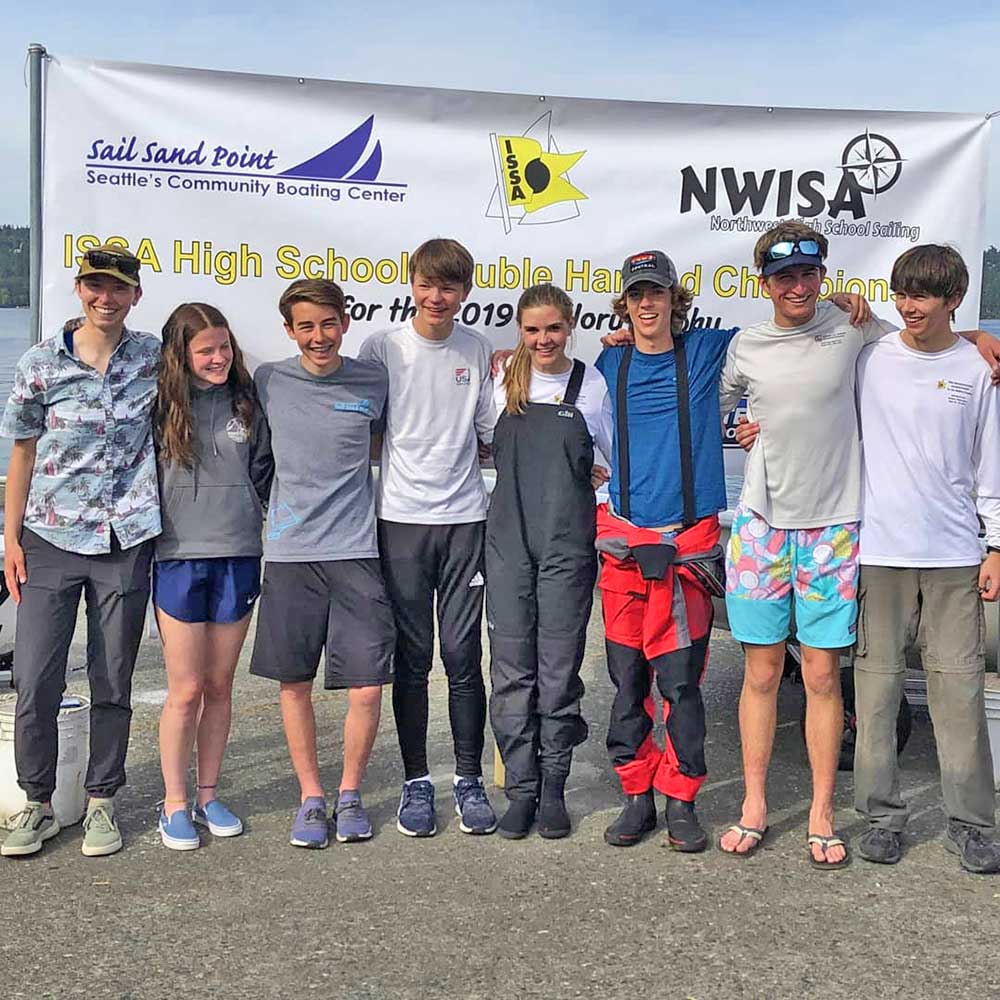
Is it your opinion that most areas in the Northwest, with the right kind of leadership and recruitment push, could significantly grow youth sailing beyond its present capacities and participation levels?
Absolutely. Sailing sells itself. In the big picture, kids and teenagers are all the same. It’s not that the kids in Olympia just happen to love sailing way more than the kids in Poulsbo or Everett. It’s just about getting the person that has the knowledge, skills, and motivation to get somewhere and get people excited about it. We all know as sailors that once people do it, they’re going to fall in love with it and want to improve just for the sake of that pursuit of excellence. From the community that the kids create to the adventures on the water or the experience of traveling—it’s just about providing that structured framework and doing the hard work of creating the place for it to happen.
Now that I’ve been doing this for four or five years and I can look back; I see communities that are trying to start and they all just need that special kind of person to come in that has the hard skills and knowledge of sailing to do the work of coaching and running the program, but also just the excitement and the passion for it. A lot of college sailors have both of those things. Here in the Northwest, we’re producing sailors that can do this and we have communities that are ripe for growth and potential.
What other elements contribute to the success of the programs you’ve been a part of?
It’s not about finding a material person who is already uniquely qualified, it’s more about finding a passionate person who probably still has a lot to learn and needs to do a lot of their own growing. But they need to have fertile soil in which to grow. So, organizations need to be able to say, “YES!” And stop saying, “no.” It’s the most frustrating thing to me and it is really insidious because organizations and groups don’t realize they’re doing it. Often when you present new ideas or bring up change to help something evolve, you’re always going to hear things like, “Well, we can’t do that because of this,” or “We tried that this way already.” Those are all just versions of no. We all have to be open to doing something new and exploring, otherwise we’re never going to get anywhere. It’s something I have run into a lot—it’s exhausting. What I’ve realized is that a lot of people who say no drift away quickly. They’ll be strongly negative at the onset, but if you just keep being the positive, persistent voice, you will outlast them. It’s like a game of Survivor.
The other big thing is just trusting the process. I trust that sailing is an amazing activity that everyone deserves to partake in, and that anybody that does it the right way is going to fall in love with it and enjoy it. I believe that 100%. Other people have that conviction too; and when you start bringing those people together and letting them run with things, incredible things are possible. So much of the success of Olympia has to do with the parents who are involved—the fundraising they do, the fact that they’re getting their kids to events, doing community outreach. The retired members of our communities build skills and apply them to repair our boats or run races. They all volunteer for free out of the love of the sport and the kids. The kids themselves are so motivated: they give up their weekends to go to regattas, share skills and knowledge with their teammates, display their passion with others and bring new sailors into the program, and many eventually choose to become sailing instructors to give back in the summers.
It’s about allowing a community to grow, and getting out of the way of that growth. Just let it explode and you’re going to be really surprised with the results. Everybody really means well, but it’s harder when faced with defeatism at the onset. There’s always a way to make something happen, I truly believe that.
What is the most important aspect to growing youth sailing around the region?
The number one thing is being a “full circle program.” This means you provide an experience in which a child can participate not only year-round, but over the course of their adolescence. You provide them both a community and an avenue to be something and do something from adolescence to adulthood. There are so many fractured programs where they expose kids to sailing during one season and then it’s lights off the rest of the year. They might run great summer sailing camps, but that’s all they do. There are programs that have great high school sailing teams—so they have boats, they get kids sailing competitively in the fall and spring, but they don’t have any summer camps and they don’t teach younger kids how to sail. In doing so, they also miss out on providing job opportunities for the high school kids they have.
It’s that full circle approach that is so important. You’re not going to retain these kids and get them sold on becoming lifelong sailors if they don’t do it all the time. We’re competing against other sports that use this model—you do the sport year-round. I can’t think of a sport that I would want to do year-round more than sailing. There are so many different avenues to keep sailing other than just competing, from cruising with your family to STEM learning to adventure sailing. Even across different sailing pursuits, programs have to work toward that full-circle approach.
Do you have sailors who participate in other sports?
Yes and no. Our core team members are diehard sailors: it’s their only sport and that’s the reality of it. I have some conflicting opinions on this, and that’s probably a different conversation about specializing too early. For kids who want to be really competitive and do well at Nationals or win events in other classes—they have to be 100% committed to the sport. I don’t think that’s necessarily a bad thing, but it is for some kids. For some, it’s not going to be their thing. For others, they are just all-in 100% and they tend to be the best performers because they spend the most time doing it. They’re not extraordinary natural talents or something, they’re just devoting all of their time.
Just as important, though, are the kids in the next ring of engagement—those who participate seasonally. They’re good sailors, they know what they’re doing, they teach sailing or volunteer in the summer. This group of kids is extremely important because they bring passion, humor, teamwork, and loyalty to the program. They are the ones that have a lot of other things going on in their lives. I have kids that are in youth orchestra, soccer, swimming, marching band, or are active volunteering for various charitable organizations. These are kids who are really well-rounded and well-connected community members.
US Sailing is working on a new initiative that they are modifying from US Hockey. It is this concept of “squaring the pyramid.” When we think about specialization, it has been this food-pyramid-type diagram. There’s a broad base where everyone is learning to do the activity through intro programs. Yet, as you move up in skill sets, the pyramid narrows, implying that the number of people participating gets smaller and smaller. So, if you’re not progressing as much as others, you stop doing the activity entirely. There are a lot of sports that have a decline of participants up to the elite levels.
Squaring the pyramid is this idea that even as people move away from the competitive pillar, they still continue to evolve and climb that ladder of skills and participation. Sailing lends itself really nicely to that because there are so many recreational opportunities to go sailing: there’s a range of racing classes with differing levels of competition; not to mention the possibilities of cruising long distances or locally with family and friends.
Part of this is pushing materials that illustrate non-competitive alternatives: adventure-based sailing for kids or STEM education. One of the things they’re already finding is the kids who do adventure sailing earlier become competitors later on, and become some of the most successful sailors because they develop this love of the sport first and it sustains them when competition gets rough. I’m really excited to see where that initiative goes.
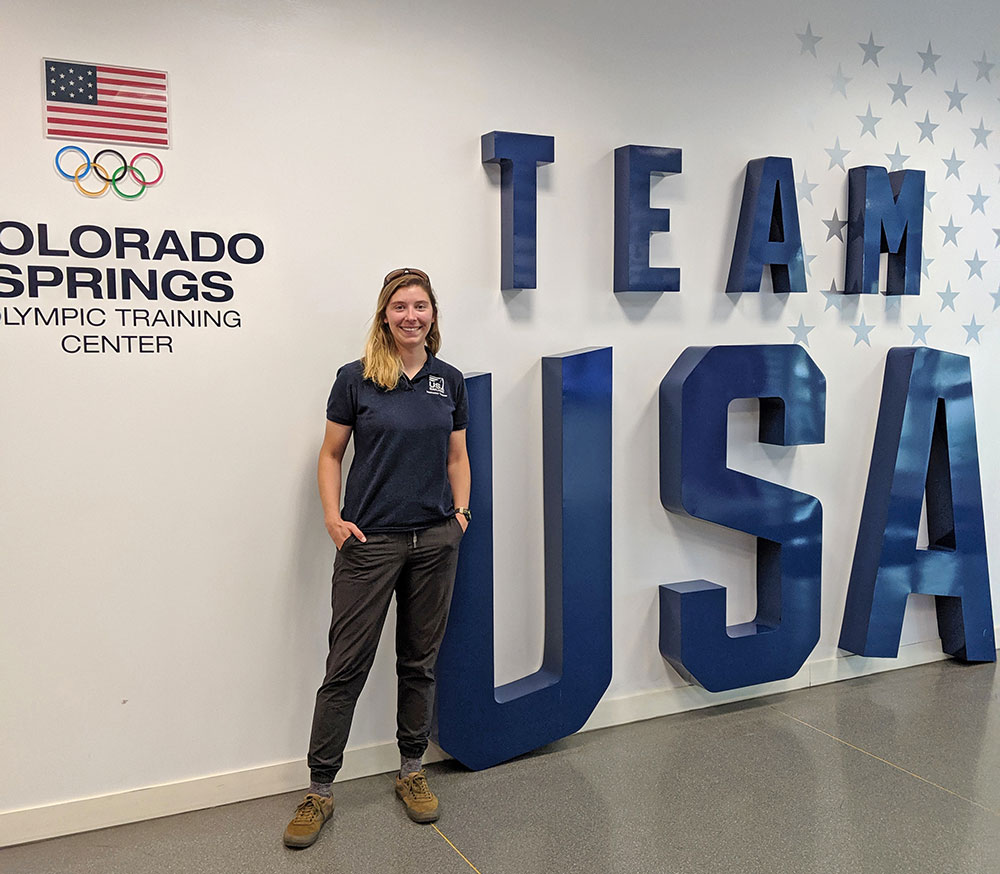
How do you describe your professional sailing involvement now, with Olympia Yacht Club and other organizations?
It’s kind of all over the map. I’m the Director and Head Coach of Olympia Yacht Club’s program. That involves managing a summer staff of 12-14 instructors. In the fall and spring, we have two or three part-time coaches. We’re hoping to be able to hire a second full-time position this year. While part-time coaches are phenomenal, you can’t task them with the same kind of bigger picture projects that you can a full-time person.
I’m also an Instructor Trainer for US Sailing. So I teach Level One certification courses, which is cool because I’m certifying the kids who will become sailing instructors, not only in Olympia but around the region. This is a great way to get to know the youth of the area. The training that I’ve done with US Sailing has connected me with that organization on the national level. One of my mentors at US Sailing suggested I apply for an International Olympic Committee (IOC) year-long Masters Coaching Enrichment Program. I was accepted and that’s been amazing because now I’ve been in a program that isn’t just about sailing but is about sports coaching on a global plane.
I was able to do a project about women’s coaching in particular, and with the help of US Sailing, the IOC, and local partners, we were able to run the first-ever Women’s Coaching Clinic this winter in Seattle. It was just awesome. The hope is to run more of those around the country.
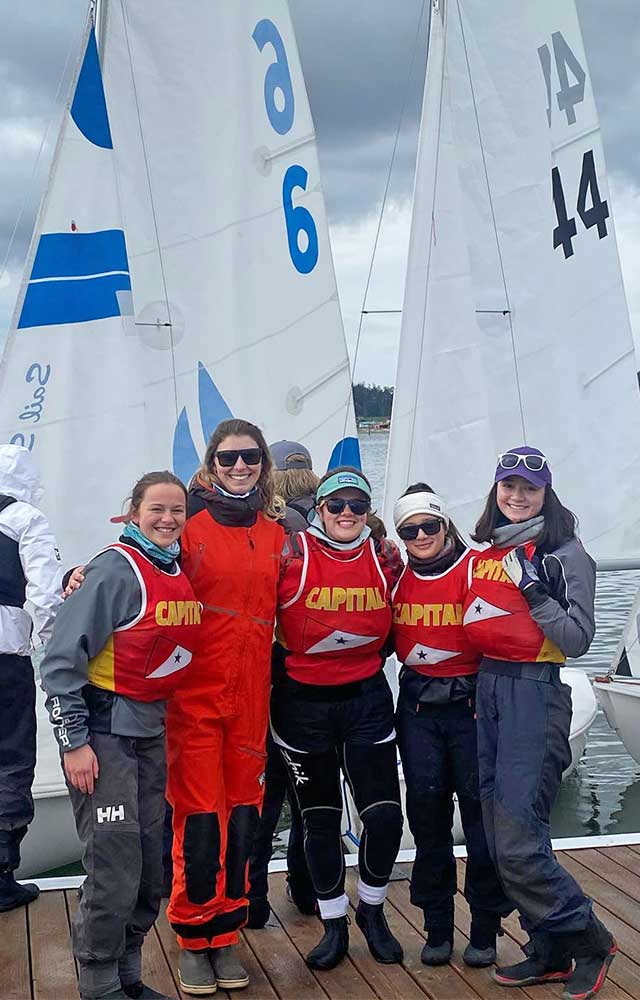
Please tell us more about your efforts to empower and increase activity for women and girls in sailing.
That’s another thing I’m involved in: the Northwest Interscholastic Sailing Association (NWISA), which is the regional body that governs all the High School Sailing Events. I’m one of the officers of that program. Nino Johnson from Sail Sand Point is the Director. There are so many wonderful connections around the Northwest. I work with The Sailing Foundation and Andrew Nelson, the Youth Sailing Director, a lot. What’s really fun for me is that a lot of them are Western Sailing alumni, or collegiate alumni from other teams.
Anyway, at the ISSA level (national high school sailing governing body), they implemented a Women’s Championship. Every region could send female-only teams to compete. We had so many women’s teams around the Northwest that wanted to go, but not all of them could; so we had to come up with a qualifying event. It all happened organically.
We’ve run three years now of Northwest High School Girls Championships and we hosted the most recent one in Olympia. Collectively as a district, we try to have those events run by all-female Race Committee to create that atmosphere where female sailors really feel empowered; that they can take on either role in the boat (either the skipper or crew position); they can be a 360 sailor, an athlete. Optically, if they’re seeing women run the races too, it’s giving them the subconscious impression that there are possibilities for women at all levels of the sport and the community. When girl sailors don’t see any female judges or any female race committee or any female umpires, it’s subtly reinforcing for those girls that that’s not something women should do or can do. So when you have more balanced gender roles across the adult and youth spectrum, that is more representative of what society should be. It’s not a ‘rah-rah-rah women are better than boys’ kind of a thing, it’s about trying to carve out a space where the girls can be empowered. And sometimes it’s helpful if it is all women, initially.
More and more organizations are getting their toes wet with events that encourage women and girls to participate—that this is still considered somewhat progressive is crazy to me. Now we have a lot of the conversation about diversity going on. That’s really where I would love to see us go—to start having events that are about diversity. If doing it for women first is how we get used to the idea of breaking up the norm, that’s great. But the next step is that we need to get a little more crazy.
What else is on your mind in terms of increasing inclusiveness in sailing?
For women, when we had our Women’s Coaching Clinic, we brought twelve female coaches from around the region. We had break-out discussions with that group about: ‘Why do we see this trend toward male skippers and female crews?’ The more competitive the events get, the more you see male skippers and female crews. At Nationals, you could count on one hand the number of teams that have female skippers. It was just dismal. And that’s in all youth sailing events, unless it’s an event specifying female skippers, like Leiter Cup.
So, it starts with the coaches and sailing instructors, with the 16-year-old staff members. When they have ten brand new kids in an Opti beginner class, are they reinforcing gender stereotypes with their own biases, and not even knowing they’re doing it? Are they putting the boys on the helm more than the girls? Are high school coaches doing the same things – putting on occasional “crew races” so the girls get to skipper and they think that they’ve checked that box?
I was very aware of that when I had the opportunity to run a team from square one. We went from three or four kids to 20-plus high schoolers in one season, so I had 90% of the kids who didn’t know anything about sailing. So I consciously chose to make all the girls that signed up skippers, because nobody knew any different; there was no precedent on our team. Our first fall, we had seven-to-ten female skippers and all the boys were crewing. When they went to regattas, maybe they were starting to do the math. I’m getting to see the dividends of that now four years later. I have all these incredibly strong female skippers on my team, and a really balanced breakdown of female and male skippers, because now that’s our team culture.
It really starts with the leaders of organizations, but it comes down to training the staff to be aware of those biases and make an effort to create fair opportunities for both genders to participate. You’re not going to diminish the boys’ experience by propping up the girls to skipper more initially, because if some girl does a lot of skippering and ultimately decides the crew position is where she feels most comfortable, that’s fine. But at least she’s perfectly sound at steering the boat and confident to do so if she has to. A lot of people who crew really only wind up with 50% of the skill set required to sail. I can’t count the number of times I’ve come up to a boat in trouble and you can’t put the crew on the helm because they don’t know how to skipper.
To go to the diversity issue, people need to see other people doing the things you’re trying to get them to do. If we want to bring more diverse people into sailing, it really helps if there are diverse people already doing it—people of color who are instructors or coaches. What happens is that you have diverse kids come in and all the staff are white, all of the people in the office are white, all of the other students are white. For people of color, they’re not seeing a community that is representative of who they are. That’s really hard. We have women and men involved in sailing, and it’s easier to work on getting women into more leadership roles. It is much harder to get more diverse people into those leadership roles because there isn’t diverse participation in the youth setting yet—they’re not in the “pipeline.” And I don’t know the best ways to do that, because I can’t say our program has done a good job of that, or any that I know of in the Northwest. I just know we have to keep working hard to grow the sailing community and make it a more welcoming place.
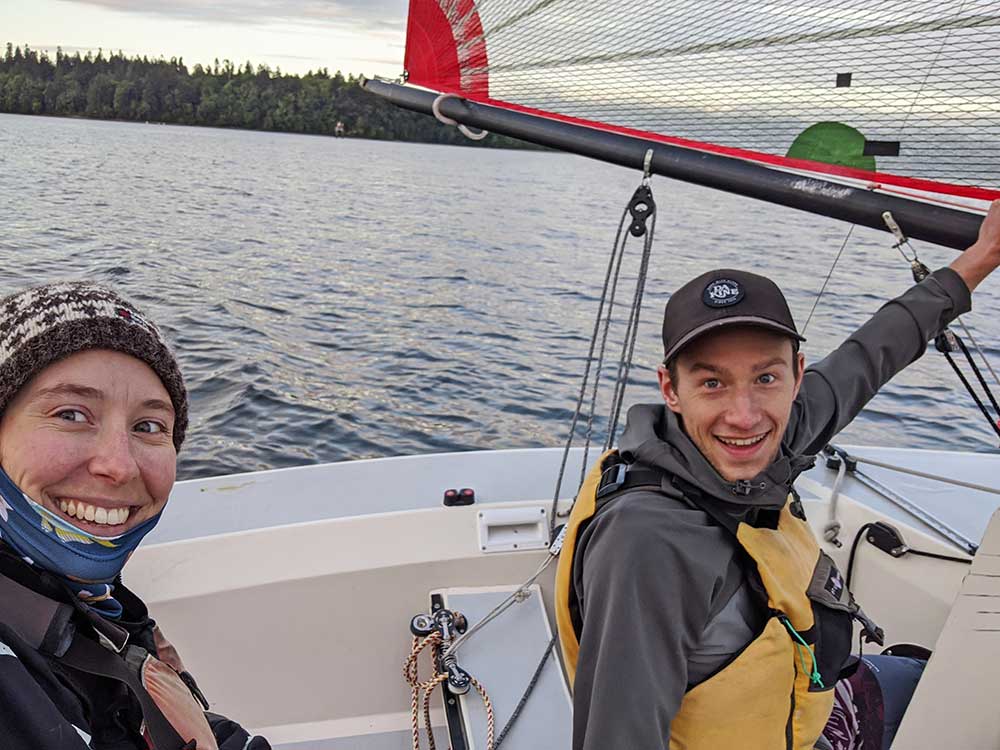
How do you personally like to go sailing today?
A downside of coaching professionally is that you’re coaching regattas on weekends instead of sailing in them, and summers are your most busy time. But my partner, Casey, and I own two Tasars and one Star. One bizarre silver lining of coronavirus is that I have been sailing more recently than I have in a long time.
Olympia is a fun and kind of funky place to sail. The South Sound Sailing Society is an active group that runs PHRF and beercan races. We don’t do a lot of keelboat sailing because, as dinghy sailors, we like our races fast and appreciate the instant gratification. But we’ve done some keelboat stuff like Swiftsure, and we’ve done some cruising.
There’s a little Star fleet here, and we primarily sail the Star just for fun. I think Casey and I weigh maybe 300 pounds together, so we’re not ever going to have a competitive campaign in our future, but that’s a great boat.
We bought two Tasars because that’s a great dinghy and a fun class that’s really strong in the Northwest. The North American Tasar fleet is hosting Worlds at Shilshole next summer. So that would be our first Worlds event. We just want to do it for fun, and to try to sail together without wanting kill each other. We’ve been sailing a couple of times per week when we can manage it.
Other than that, Casey and I sail with the kids. I’ll hop in the boat with a kid at practice. I met Casey on the sailing team at Western and he’s a great sailor. So he’ll come down to help coach and sail with the kids at practice too.
Who is one of your sailing mentors and why?
I have a lot of them, but the person I often point to is Andrew Nelson, who is now the Youth Sailing Director at the Sailing Foundation and runs the youth racing circuit.
He was a senior and the captain of the Western Sailing Team when I joined as a freshman. He’s a really big personality. He’s really funny and gregarious. I was really shy and awkward. I remember that fall season on the team, I was just out of sorts—transitioning to college life, having a lot on my plate with school, and having all these other things going on. I didn’t know if I wanted to keep with sailing. I accidentally picked this carpool to sailing practice and Andrew was the driver. He was so intimidating in a good way.
When I told my mom I was thinking about quitting for a while and just focusing on school, she asked, “Well, what is Andrew going to say?” I don’t want it to sound like I was afraid of Andrew, he was just such a good captain and so passionate, and the fact that he was this senior driving a bunch of dorky freshmen to practice every day… I just didn’t want to tell him that I was having doubts because I really respected him. That opened up the team for me.
At the end of that year, he gave me the Captain’s Heart award (an annual award given to one member of the Western Sailing Team) noting, “You would text me at 11:00 at night with a question about a regatta for the next weekend.” I had no idea that Andrew had noticed my passion for the team and how stoked I was on it.
We’ve been able to stay friends and collaborate for years since then. He’s the one who got me in touch with US Saling when I was right out of college. Even to this day, we talk on a weekly basis, about sailing and stuff. I just would not be anywhere I am without Andrew Nelson being a good friend, a good teammate, and just being a person dedicated to the sport of sailing in the Northwest.
What should I have asked you about?
I love talking about the kids on my sailing team. Each individual kid is just such an amazing person. Our team is a collective of the high school varsity program, the junior varsity program, and our Opti racers who are as young as third grade. All three are active year-round. I miss them so much not being to run regular practices and be on the water with them. I’m doing Zoom chalk-talks twice per week with all age groups, and to have them still engaged and asking questions, week after week after week without getting to go sailing—it makes me so happy, but also so sad that we can’t do our thing right now.
I love them so much, and I’m so proud of them for so many other reasons than just sailing—the way they treat each other as teammates, the dedication they give to something they’re passionate about, the amount of hard work they put in. It just blows my mind.
Joe Cline
Joe Cline has been the Managing Editor of 48° North since 2014. From his career to his volunteer leadership in the marine industry, from racing sailboats large and small to his discovery of Pacific Northwest cruising —Joe is as sail-smitten as they come. Joe and his wife, Kaylin, have welcomed a couple of beautiful kiddos in the last few years, and he is enjoying fatherhood while still finding time to make a little music and even occasionally go sailing.

